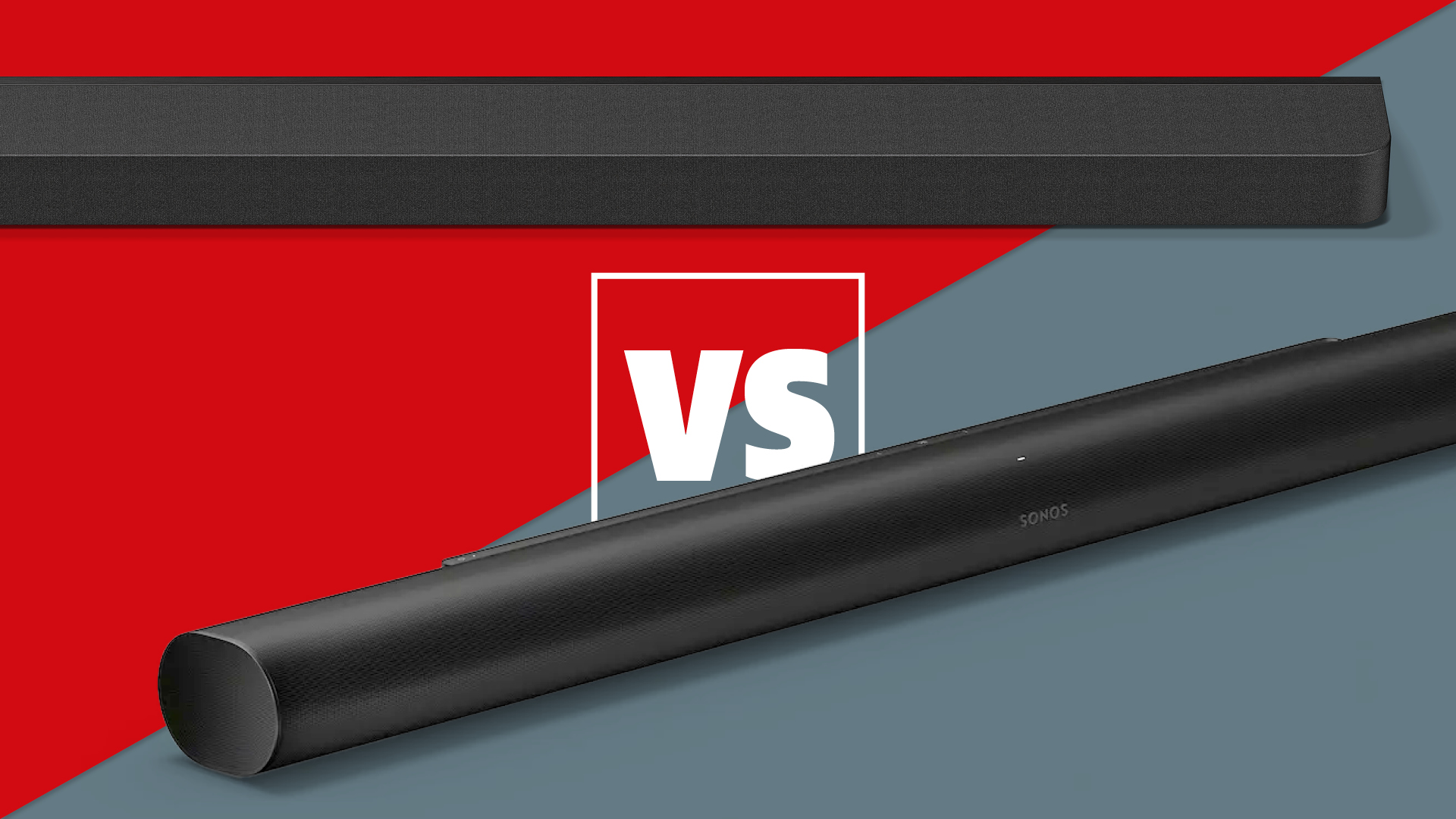Sonos Arc Ultra vs Sony Bravia Theatre Bar 9: which flagship Dolby Atmos soundbar is better?
It's Sonos vs Sony in this battle of premium Dolby Atmos soundbars...

Connections: HDMI, optical, ethernet
ARC/eARC: eARC
Bluetooth: Yes
Dimensions (hwd): 7.5 x 118 x 11 cm
Weight: 5.9kg
A real step on from the Award-winning Arc, the Arc Ultra packs more drivers, more bass and a more detailed sound than its predecessor. It's more precise than the Sony, but not quite as spacious, and the lack of HDMI ports could be frustrating for gamers.
For
- Clean, precise, spacious and three-dimensional sound
- Deep, tuneful and expressive bass
- Terrifically detailed for a soundbar
Against
- No HDMI passthrough
- No DTS support
- Still some app issues

Connections: HDMI out, 1 x HDMI 2.1 in
ARC/eARC: eARC
Bluetooth: Yes
Dimensions (hwd): 6.4 x 130 x 11 cm
Weight: 5.5kg
The Bravia Theatre Bar 9 actually digs a little deeper in the bass than the Arc Ultra, but isn't quite as detailed. But it's a more open, spacious sound overall, supports DTS:X (which the Sonos doesn't) and has better connectivity thanks to its HDMI ports. Existing Sonos user? You might be better served by the Arc Ultra...
For
- Superb clarity, detail and punch
- Impressive 3D audio processing
- Classy, subtle design
Against
- Slightly clinical in its delivery
- No display
- Occasionally over-pronounced deep bass
If you’re shopping around for one of the best soundbars, chances are you've come across the superb, five-star Sony Bravia Theatre Bar 9. Then again, if you’re already invested in the Sonos ecosystem, it’s likely that the Sonos Arc Ultra is also on your shortlist. Decisions decisions…
Both are five-star soundbars, and both cost a pretty penny. But which would be best for you? We've put both through their paces with our typically thorough reviews process, so we can help you find the best 'bar for you.
Sonos Arc Ultra vs Sony Bravia Theatre Bar 9: price

While both soundbars sit firmly in the premium category, there's a notable price difference between them. The Sonos Arc Ultra comes in at £999 / $999 / AU$1799, positioning itself as Sonos' new flagship offering, but Sony has set the bar a fair bit higher with the Bravia Theatre Bar 9, which is priced at £1399 / $1400 / AU$1795.
So, a £400 / $400 difference then? Not so fast there. Because the Sony 'bar has been reduced to £999 / $1098 in recent sales, bringing it broadly in line with the Sonos. With the Sonos model only just launched, don't expect any significant discounts anytime soon. But because of the chance that the Sony could return to its RRP, and because of its lower price in the US, the Sonos takes this round. Just.
** Winner: Sonos Arc Ultra **
Sonos Arc Ultra vs Sony Bravia Theatre Bar 9: design and build

It might look very similar to the original Sonos Arc – with the same perforated design – but the Arc Ultra does have some differences. It's a bit lighter than its predecessor, and while it is a little wider, it is less tall, and so less likely to obstruct the bottom of the TV screen. Overall, it's 18 per cent more compact, yet promises a bigger sound (more on this later).
There's also a new ledge at the back of the top of the chassis that houses the touch controls, while the Bluetooth pairing button is hidden in the recess around the back with the HDMI and power ports, making it a bit awkward to reach.
The slightly longer Sony Bravia Theatre Bar 9 impresses with its subtle yet sophisticated design, and it contrasts Sonos’ design philosophy with a fabric cover that shrouds 90 per cent of the bar's visible surfaces, lending it a soft, discreet appearance that blends seamlessly into most living spaces.
Despite their different design philosophies, both devices are about as visually appealing as a soundbar can get and, depending on your preferences, you should be happy with whichever one ends up gracing your living room.
** Winner: Draw **
Sonos Arc Ultra vs Sony Bravia Theatre Bar 9: features

Both soundbars come packed with features aimed at delivering a premium audio experience. The Sonos Arc Ultra boasts a 9.1.4-channel configuration and introduces Sonos' new 'Sound Motion' technology, which Sonos claims revolutionises bass performance in a compact form factor. It supports Dolby Atmos but not DTS:X.
The Sony Bravia Theatre Bar 9 counters with its own impressive spec sheet. It houses 13 individual drivers and quad passive radiators, all working in concert to create Sony's 360 Spatial Sound Mapping. This technology aims to create a dome of sound that extends well beyond the physical confines of the soundbar, and it's compatible with Dolby Atmos and DTS:X.
In terms of connectivity, the Sony edges ahead with its inclusion of an HDMI 2.1 input that supports 4K/120Hz, VRR, and ALLM – a boon for gamers. Disappointingly, the Arc Ultra does not have any dedicated HDMI inputs, so all sources need to be routed through your TV and out to the soundbar via its eARC connection.
Both soundbars offer a range of wireless connectivity options, including Bluetooth, AirPlay and Spotify Connect.
Room calibration is a key feature for both models. Sony's Sound Field Optimisation has proven effective in our tests, while Sonos' Trueplay technology, now available for Android users with the Arc Ultra, is a great feature, too.
Of course, like all Sonos speakers, the Arc Ultra works seamlessly with other Sonos speakers, and so can be expanded to a full surround system with the addition of extra units (like the Era 300, for example), or work as part of a multi-room set-up. But for anyone without other Sonos speakers, this ability will mean nothing.
** Winner: Sony Bravia Theatre Bar 9 **
Sonos Arc Ultra vs Sony Bravia Theatre Bar 9: sound

With both 'bars earning five stars from us, you know both are going to sound fantastic.
The Sony Bravia Theatre Bar 9 delivers sound with exceptional clarity, detail, and punch. It creates a convincing 3D soundstage, with excellent spatial organisation that makes it easy to track individual elements within complex audio scenes. It’s one of the best soundbars we’ve tested when it comes to providing a real sense of openness and space, which is no mean feat.
The Sony's dynamic range is particularly noteworthy, handling both subtle nuances and dramatic swells with aplomb. Its bass response is deep and weighty, though we did note that, occasionally, particularly deep bass notes could be slightly over pronounced.
And the Arc Ultra? It's another proud entry into the Sonos canon, and upholds the brand's reputation as maker of some of the most musical soundbars around.
It's a real step up from the original Arc, which is doubly impressive when you consider that that model is a multi-Award winner. The Ultra has more precision, crispness and tightness, which makes the original Arc sound a little casual by comparison. But it's when you fire up the movies that this difference is really brought into sharp effect.
Sonos claims the Ultra has twice as much bass as the standard Arc. The bass definitely goes deeper, but it's the quality of the bass response that really impresses. There’s no chuffing from the drivers and it has a really good go at the super-deep notes of Blade Runner 2049 – its balance of weight and control is something to behold.
The Ultra's spatial sound placement is also very impressive, not just for its sense of space, but for the level of detail on show.
So which soundbar sounds better? The Sony extends a little deeper into the bass, but its low end is less well defined. It’s also a little less detailed and dynamically nuanced. But then the Sony is even more open than the Ultra, with an even more spacious sound.
With both 'bars costing the same, it really comes down to what you prize more: deeper or clearer bass? A wider soundscape or greater precision? We recommend giving both a listen before you make your mind up.
** Winner: Draw **
Sonos Arc Ultra vs Sony Bravia Theatre Bar 9: verdict

There really isn't much to choose between these two, especially with the Sony's price having dropped to equal the Sonos'.
In terms of design and sound, it's pretty much a dead heat, with the Sony edging ahead in terms of features largely thanks to its superior HDMI connectivity. But then if you have other Sonos speakers, the Arc Ultra will slot seamlessly into your set-up, and chances are that will make it the better device for you.
It ultimately comes down to your needs – this one is too close to award a clear winner. Like we said at the outset, decisions, decisions...
MORE:
Which Sonos speaker should you buy? Find out here
Check out the best Dolby Atmos soundbars
Read our Sonos Ace review
Get the What Hi-Fi? Newsletter
The latest hi-fi, home cinema and tech news, reviews, buying advice and deals, direct to your inbox.
Joe has been writing about tech for 20 years, first on staff at T3 magazine, then in a freelance capacity for Stuff, The Sunday Times Travel Magazine (now defunct), Men's Health, GQ, The Mirror, Trusted Reviews, TechRadar and many more. His specialities include all things mobile, headphones and speakers that he can't justifying spending money on.

